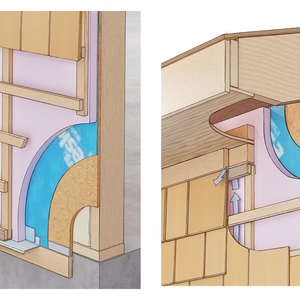Adding polyiso to the interior of a vaulted ceiling
Need some input on designing a functional insulated vented/unvented ceiling while still keeping with the homes original style. This is a Mid century modern home built in 1954 located in the central valley of California. ( USDA zone 9b,10a ) The house in general has blown in insulation between 2×12 ceiling/roof rafters installed by the previous owner. Which even in the middle of summer with weeks of +100 degree heat keeps those areas comfortable. My issue is with the front room with its mono sloped design and exposed to the interior Douglas fir T&G roof planking. While the architecture is stunning, the R rating is non existent.
Since the rolled roofing is new (2 years old) striping the roof and putting polyiso on top doesn’t seem like the right course of action. So my thought is to frame an additional ceiling at -6 1/2” down from the bottom of the existing roof. Install 4 1/2” of iso between the new joists and leave a 2” air space from the insulation to the roof. This air space would run continuous from a soffit vent to the high side of the roof. DOES THIS SEEM VIABLE ? How and or should I air seal this ?



















Replies
It's not clear what size the roof rafters are. That might be a factor since you'll be adding a fair bit of dead load to the roof. If they are also 2x12's perhaps you might consider blowing in insulation there as well. In your location you are insulating to control overheating, as you say, so you don't need to worry about moisture migrating into the insulation from the interior. The T&G ceiling is likely not much of an air barrier, but again that won't be a problem in your location. Even with air conditioning, the outdoor humidity is typically low enough that moisture condensing from that direction will not be a problem either. So a venting channel above the insulation is not necessary, and could create a problem if you do use air conditioning.
Try getting an estimate from a reputable insulation contractor to see what that option looks like. That person could advise you about what might be workable in that approach. It seems the least disruptive of the existing situation, which is worth saving as is.
What are the rafters in this section? Or is that included in the 6 1/2"? You could consider putting some of the polyiso as continuous sheets to break the thermal bridge and be able to air seal the polyiso.
Ok i've attached a rough drawing of my floor plan. From what im reading, the use of a air gap and air sealing isn't necessary in my particular region? So I should move the insulation up to the bottom of the roof and fill the entire void created by the new ceiling framing? Maybe 1'' polyiso + R-19 batt = R25 or do you think its worth the money to go with solid polyiso = a potential R36. Any opinions are appreciated, Thanks.
Thanks for the sketch, much more clear. I've worked with polyiso quite a bit and I believe you can save yourself some trouble and money by just using that. Find a roofing supplier or someone who sells polyiso recycled from a commercial roof (check Craig's list or similar). Ideally you could find 3 1/2" or 4" thickness, but you can use whatever is available by using two layers. You will need long screws and washers made for the purpose (a roofing supply, online or local.) to attach it to the underside of the roof deck. You could also use plaster repair washers if you can find them. You can also use glue, but you'll still need to fasten the sheets in place minimally. If you use a couple layers offset the joints to minimize air getting past, but I imagine it will be minimal since it will have nowhere to go.
So far you're working over your head with relatively lightweight material. If you want to be detailed about it, get yourself a pro style foam gun and caulk any seams or gaps (the Big Box has a version that will serve for this job.) A foam gun is a hassle to keep clean and working but it is way better than the canned stuff for overhead.
Skip the 2x4's and screw 1x4's flat on whatever centers you will use to attach the gyp board. Put the this strapping up securely with more long screws.
I've found that cutting polyiso on a table saw is pretty straight forward , but I've cut plenty by hand or a jigsaw. It makes dust especially if you get the felt surfaced rather than the foil, but still beats using batt insulation overhead. Attaching the 2x4's as you suggest would also be a task if working alone. If you have to, screw a temporary ledger against the side of one beam to catch the end of the board away from your end.
This approach will work in cold climates, so I'm sure it will work in your moderate ,dry location. i don't think this will add too much weight for a 7 foot span on your 2" T&G. I would worry more about the sag in a 2x4 over that span.
Good luck!
The air gap will only work if air can come in (i.e. soffit) and a way to leave through a roof vent (ridge, gable, turbine, etc). You can build an unvented roof, but air sealing will be very important as it would only be able to dry towards the inside.
I was suggesting putting the polyiso on the bottom of your 2x4 framing for your new ceiling, but that will only work if it is a vented roof as it reduces the ability to dry towards the inside.
You might want to check out this article.
https://www.greenbuildingadvisor.com/article/how-to-build-an-insulated-cathedral-ceiling
You could repost your question there - there are a couple very knowledgeable about the what code wants for your area and ratios of rigid to fluffy insulation, etc to build a safe assembly.